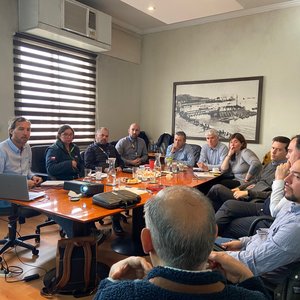Fish nutritionist Scott Sindelar examines yellow perch in a 1,000-gallon tank.
Two South Dakota State University researchers just got a little closer to their goal—marketing high-quality commercial fish feed ingredients made with plant-based proteins.
This fall Prairie Aquatech became the first tenant at the Agricultural Technology Center for Rural Enterprises, the 30,000-square-foot, city-owned Brookings Research and Technology Center.
One part of the building will be used to convert feedstock, such as soybean meal and distillers’ grains, into feed ingredients. Another part will be used to conduct fish nutrition research, while yet another will house analytical labs and office space.
Partnering for success
Professor William Gibbons of the biology and microbiology department and Distinguished professor Michael Brown of the natural resource management department developed the patent-pending microbial process that increases the protein content and digestibility of soybean meal. Brown, a fisheries expert, determines the percentage of soy product that can be used to replace expensive, marine-derived protein yet maintain a nutritionally balanced diet for the fish.
The collaborative work began in 2011 with a three-year grant from the South Dakota Soybean Research and Promotion Council and the United Soybean Board. Additional support came from the South Dakota Agricultural Experiment Station and Sun Grant Initiative with equipment funding through the South Dakota Board of Regents and the Legislature.
In 2012, Gibbons and Brown worked with South Dakota Innovation Partners to start Prairie AquaTech. Work has also been done with dried distillers grain, a coproduct of the ethanol industry.
Assistant Vice President for Technology Transfer and Commercialization Will Aylor said typically university technologies are licensed to existing companies at base scale, which leaves a lot of questions unanswered. “It’s like looking through a pinhole,” he said, and further development expands that view.
Scaling up the technology gives the researchers answers about size, cost and effectiveness, which add value, according to Aylor.
Testing process on larger scale
“We will be able to test our processing conditions at a larger scale, and under continuous or semi-continuous operating conditions that will simulate commercial scale production,” Gibbons said. The feed ingredient production side includes a milling system, two 3,000-gallon processing tanks, a continuous flow centrifuge and a drying system to produce the plant-based protein.
Conversion processes often need to be modified as the scale increases, he explained, pointing to mass transfer issues and energy requirements, and even the effects of increased shear or turbulence on the microbes.
In addition, the microbes may perform differently when they are cultured for extended times, Gibbons pointed out. “We can’t simulate this on the bench so we need the pilot-scale facility as a transition stage to allow us to then move to commercial-scale production.”
Gibbons also hopes to expand his experiments to alternative oilseeds, such as canola, flax, crambe and Ethiopian mustard.
Expanding fish feeding trials
On the fish nutrition side, Brown can expand feeding trials to more fish species and increase the length of the trials. The new facility houses 120 30-gallon tanks in three systems, 36 50-gallon tanks in one system and 18 1,000-gallon tanks in two large systems, as well as 12 200-gallon tanks in three systems for digestibility trials and fish quarantine needs. These recirculating aquaculture systems have chillers and heat pumps to accommodate cold, cool and warm water species.
“The large systems will be used to test feed formulations by growing fish all the way to market size,” Brown said. In a quality rearing environment and with optimum nutrition, many species can go from a small fingerling to market size in seven to 10 months.
Previous experiments focused primarily on yellow perch, rainbow trout and, to a lesser extent, tilapia. The pilot-scale facility will allow Brown to do more extensive feeding trials on trout and perch and to add hybrid striped bass and salmon.
Like traditional livestock, each fish species has different nutrient requirements, in terms of protein, amino acid and fat, Brown noted.
The number of species tested may also expand through independent feeding trials, with discussions underway for testing on high-value marine species such as yellow tail jack, red snapper and cobia. In addition, Brown and Gibbons visited freshwater and marine fish operations in China this summer to explore opportunities for feeding trials there.
In 2015, they anticipate building a small commercial-scale plant.
When it comes to commercialization of university-developed technologies, Aylor said, “they are blazing a trail that others can follow.”










